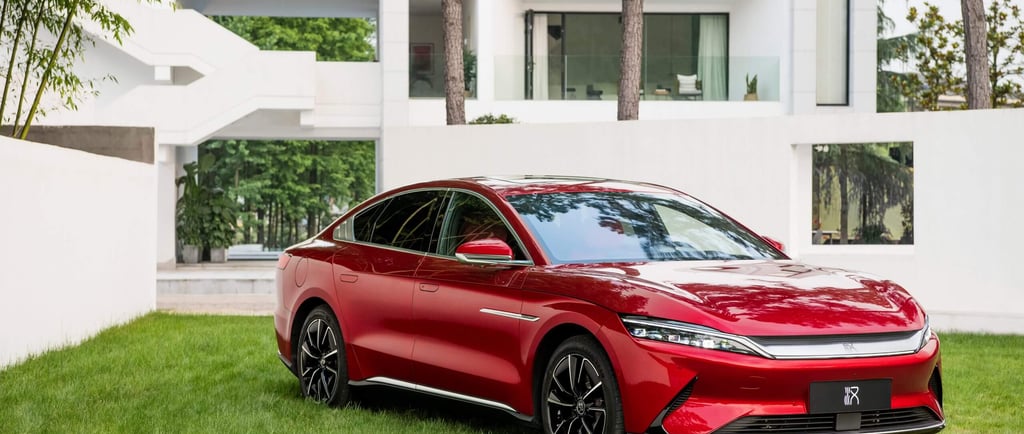BYD’s Growth Engine Sputters: Why China’s Tesla Rival Is Braking in 2025—and Why Markets Are Nervous
BYD’s decade-long surge has hit a wall—sales volumes dipped, margins shrank and even night shifts are being cancelled as China’s EV champion braces for a bumpier road ahead.
CULTUREELECTRIC CAR


BYD: The Wild Growth of Tesla’s Chinese Rival Slows—and Worries Mount
1. From unstoppable to vulnerable in one quarter
Only twelve months ago BYD was the undisputed speed king of global electrification: it outsold Tesla in pure BEVs during Q4-23, opened four new plants in 18 months and talked of hitting 5.5 million vehicles in 2025. Fast-forward to October 2025 and the narrative has flipped. Third-quarter net profit plunged 33 % year-on-year to US$1.1 billion, revenue slid 3 % and the company quietly cut its full-year sales target by 16 % to 4.6 million units—the first downward revision since 2019.
2. Price-war shrapnel
China’s EV market has turned into a “knife-fight” of discounts. Data from JPMorgan show the average rebate across 1,000 domestic variants hit a record 17.4 % in June and is still hovering at 16 %. BYD, once the aggressor, is now bleeding: its vehicle margin narrowed 270 basis points to 21 % in Q3 as rivals such as Geely and Changan launched cheaper plug-in hybrids and undercut the Seagull and Dolphin by up to 12 %. The company’s flagship Han EV has seen three price cuts since March, erasing US$2,300 of gross profit per car.
3. Inventory overflow idles factories
With domestic orders cooling, BYD’s finished-vehicle inventory rose to an estimated 550,000 units in September—equivalent to seven weeks of sales. Sources tell Reuters that at least four Chinese plants have cancelled night shifts and reduced output by 30 % or more, while expansion lines scheduled for 2026 have been suspended indefinitely. The move mirrors Tesla’s own Shanghai shutdowns in 2023, but for BYD it marks an abrupt reversal of its non-stop capacity binge.
4. Export surge: the only bright spot—so far
Overseas sales jumped 160 % year-on-year in Q3, helped by the Atto 3 in Europe and the Dolphin Mini in Latin America. Yet exports still represent only 21 % of total volume, not enough to offset a 24 % collapse in domestic plug-in hybrid deliveries. Shipping costs from China to Europe have climbed 45 % since January, while the EU’s 38 % provisional tariff on Chinese EVs threatens to cap the export escape hatch just as BYD needs it most.
5. Market share lost at home
For the first time in 18 months BYD surrendered the No. 1 sales spot in China to state-owned SAIC Motor in September. Analysts attribute the slip to product-fatigue—the core line-up is now three years old—and to competitors launching 800-V architectures, solid-state-cooled batteries and city-NOAs (navigate-on-autopilot) at similar price points. BYD’s next-gen Blade 3.0 platform will not arrive until Q2-26, leaving a six-month innovation gap.
6. Financial vital signs: still healthy, but flashing amber
Operating cash flow turned negative (-US$2.95 billion) over the last twelve months as working capital ballooned.
Debt-to-equity remains a modest 20.5 %, giving headroom for new battery plants in Turkey and Brazil, but credit-rating agency Fitch placed BYD on “negative watch” in October, citing “deteriorating pricing power”.
Market cap has shrunk 28 % since July, wiping US$40 billion off the value of the Hong Kong-listed stock and pushing the forward P/E down to 16.9—below Tesla’s 22 but above legacy Chinese OEMs.
7. Strategic pivot: up-market or die
CEO Wang Chuanfu has responded with a “double-up” strategy:
Up-market push: ramp the Yangwang U8 (US$150 k) and Fangchengbao Bao 5 (US$70 k) SUVs to lift blended ASP by 18 % in 2026.
Tech differentiation: mass-produce LFP-based 6C fast-charge cells (10–80 % in 8 min) and DiSus-X active suspension as standard on mid-range models.
Whether Chinese consumers will pay premium prices for a brand built on “affordable EVs” is the US$50 billion question now facing investors.
8. Investor takeaway
BYD is not collapsing—it still sells 1.15 million vehicles a quarter and controls the entire battery supply chain. But the era of “grow at any cost” is over. Margin defence, inventory discipline and overseas profitability will dictate whether the company re-accelerates or follows the classic Chinese boom-bust cycle seen in solar panels and ship-building. Until the new platform cycle kicks in, expect volatile monthly delivery figures and more price-cut headlines—the clearest signal yet that even China’s EV darling is not immune to a maturing, cut-throat market.
Sources
Morningstar – BYD Earnings: Revenue and Net Profit Missed as Competition Weighed on Vehicle Margin (1 Nov 2025)
Mexico Business News – BYD Posts 33% 3Q25 Profit Decline; Rivals Gain Ground (31 Oct 2025)
Reuters – BYD slows production, delays capacity expansion at China factories (25 Jun 2025)
CNN – How Tesla and its Chinese competitor compare, in 4 charts (3 Apr 2024)


